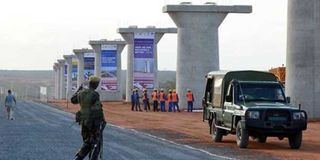KWS sets terms for new railway passage through Nairobi National Park

The standard gauge railway under construction. International financial institutions have raised the red flag on what they say is runaway government spending amid a financial crunch. PHOTO | KEVIN ODIT | NATION MEDIA GROUP
What you need to know:
- The KWS says no land will be lost and the compensation is only for the disturbance the railway will cause.
- The bridges will be a kilometre in length with an underpass height of a minimum six metres but generally a height of over 20 metres.
- Animals and visitors will have access to the eastern side of the park through several sections of the track that will be elevated on three bridges.
A plan for the standard gauge railway to run through the Nairobi National Park is facing hurdles after the Kenya Wildlife Service (KWS) laid down the conditions for its passage.
The railway is expected to run along the park’s boundary for a 12km stretch.
KWS has, however, demanded monetary compensation and that bridges be built in affected areas for easy movement of animals and visitors.
KWS spokesman Paul Udoto said the cash would be used for wildlife conservation.
The KWS set the conditions after a number of meetings with Kenya Railways and the National Land Commission.
NO LAND WILL BE LOST
The KWS says no land will be lost and the compensation is only for the disturbance the railway will cause.
“The original boundaries of the Nairobi National Park will not change and acreage will not be reduced,” KWS said in a statement.
According to the agency, animals and visitors will have access to the eastern side of the park through several sections of the track that will be elevated on three bridges.
The bridges will be a kilometre in length with an underpass height of a minimum six metres but generally a height of over 20 metres.
“It is the view of the boards of Kenya Wildlife Service, National Land Commission and Kenya Railways that allowing the railway to pass through and in places over the Nairobi National Park is a compromise situation that reflects the national interest in the larger sense, and leaves the boundaries of the park intact and unaltered,” the statement adds.
The KWS, however, advised that in future, planners and the government should ensure that major transport corridors such as rail, road and pipelines be built above the ground to allow for wildlife migration and movement, if such corridors passed through any national park.



